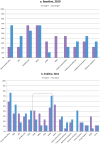Taking knowledge for health the extra mile: participatory evaluation of a mobile phone intervention for community health workers in Malawi
- PMID: 25276560
- PMCID: PMC4168601
- DOI: 10.9745/GHSP-D-13-00141
Taking knowledge for health the extra mile: participatory evaluation of a mobile phone intervention for community health workers in Malawi
Abstract
In Malawi, where the majority of the population resides in rural areas, community health workers (CHWs) are the first, and often only, providers of health services. An assessment of health information needs, however, found that these frontline workers often lacked essential health information. A pilot project, implemented in 2 rural districts of Malawi between 2010 and 2011, introduced a mobile phone system to strengthen knowledge exchange within networks of CHWs and district staff. To evaluate the mobile phone intervention, a participatory evaluation method called Net-Map was used, an approach built on traditional social network analysis. Together, CHWs and district personnel discussed information needs and gaps and the roles of different actors in their information networks. They then used drawings and 3-dimensional objects to create baseline and endline maps showing the linkages and levels of influence among members of the information network. Net-Map provided them with powerful evidence of differences before and after the mobile phone initiative. At baseline, CHWs were not mentioned as actors in the information network, while at endline they were seen to have significant connections with colleagues, beneficiaries, supervisors, and district health facilities, as both recipients and providers of information. Focus groups with CHWs complemented the Net-Map findings with reports of increased self-confidence and greater trust by their communities. These qualitative results were bolstered by surveys that showed decreases in stockouts of essential medicines, lower communication costs, wider service coverage, and more efficient referrals. As an innovative, participatory form of social network analysis, Net-Map yielded important visual, quantitative, and qualitative information at reasonable cost.
Conflict of interest statement
Figures






Comment in
-
Cell phones and CHWs: a transformational marriage?Glob Health Sci Pract. 2014 Feb 11;2(1):1-2. doi: 10.9745/GHSP-D-14-00007. eCollection 2014 Feb. Glob Health Sci Pract. 2014. PMID: 25276556 Free PMC article.
References
-
- DataFinder [Internet]. Washington (DC): Population Reference Bureau. [2005] -. Total fertility rate, Afghanistan, Albania, and 207 other locations, 2012, number; [cited 2014 Jan 10]; [about 5 screens]. Available from: http://www.prb.org/DataFinder/Topic/Rankings.aspx?ind=17
-
- IndexMundi [Internet]. [place unknown]: IndexMundi. c2013. Country comparisons: maternal mortality rate; [cited 2014 Jan 10]; [about 6 screens]. Available from:http://www.indexmundi.com/g/r.aspx?c=mi&v=2223
-
- UNICEF [Internet]. New York: UNICEF. Malawi: statistics; [cited 2013 Jan 10]; [about 5 screens]. Available from:http://www.unicef.org/infobycountry/malawi_statistics.html
-
- IndexMundi [Internet]. [place unknown]: IndexMundi. c2013. Country comparisons: HIV/AIDS – adult prevalence rate; [cited 2014 Jan 10]; [about 6 screens]. Available from:http://www.indexmundi.com/g/r.aspx?c=mi&v=32
-
- UNdata: a world of information [Internet]. New York: UNICEF. [last updated 2013 Jun 19]. Statistics: contraceptive prevalence rate (CPR); [cited 2014 Jan 10]; [about 4 pages]. Available from:http://data.un.org/Data.aspx?d=SOWC&f=inID%3A34
Publication types
MeSH terms
LinkOut - more resources
Full Text Sources
Other Literature Sources
Research Materials
